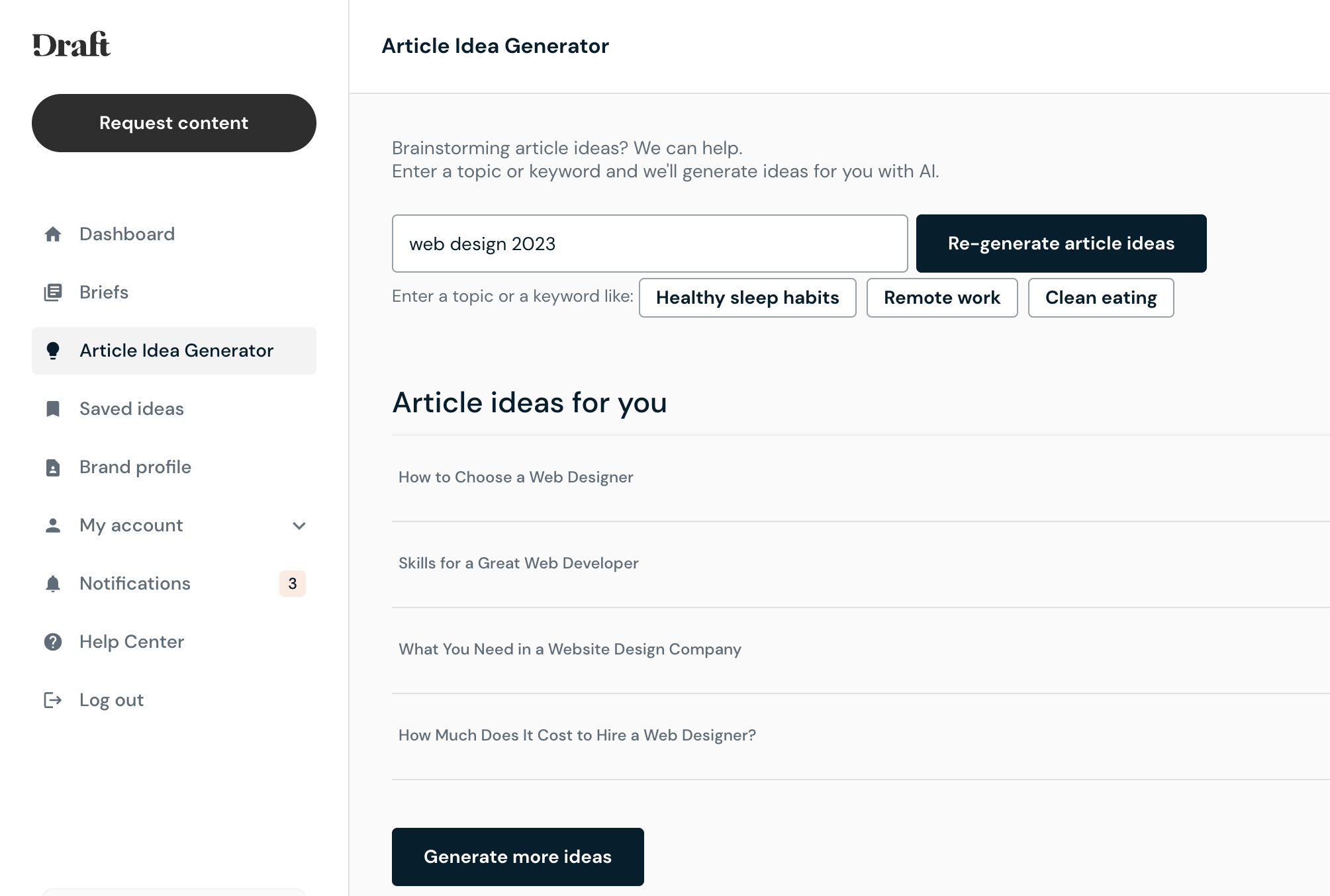How to write blog posts with AI content generators
November 4, 2022
|
John Thomas
If you’re considering AI content generators to help with your blog writing, you’ll want to keep these tips and warnings in mind.

The rise of artificial intelligence is changing every industry, and content writing, content marketing, and SEO are no exceptions. With AI continually getting better at generating human-like content, some believe it will replace human writers altogether. At Draft, we think AI is a tool that can help content creators rather than replace them.
“When AI writes a blog, it does so word by word by looking at the previous words in the sentence and predicting what the next one should be.”
How do AI blog generators work?
In order to get the most out of your robo-writer, it’s crucial to understand how AI blog writers work. Most tools on the market today stem from what’s known as natural language processing (NLP). NLP is a branch of AI that deals with analyzing and understanding human language.
OpenAI, a research company founded by Elon Musk, is one of the leaders in developing NLP algorithms. Their GPT-3 model is currently the state of the art when it comes to generating human-like text. In fact, Draft uses GPT-3 AI to power our content idea generator.
GPT-3 works by taking in a large amount of training data (in this case, a corpus of blog posts and content) and learning the statistical properties of that data. Once it has analyzed the patterns, it can generate new text that looks and feels like a human wrote it. Think of all this data as the AI’s “brain.”
The more information it has to work with, the better it can learn the patterns of human language and the more realistic its output will be. When AI writes a blog, it does so word by word by looking at the previous words in the sentence and predicting what the next one should be.
For example, if the current sentence is “Siberian tigers are the largest members of the…,” GPT-3 AI cross-references this against its training data to figure out that the next word should probably be “feline” followed by “family.” These calculations are done at unfathomable speeds.
Benefits of writing blogs with AI
As you can imagine, blogging with AI has a lot of benefits. Here’s why so many companies are using AI for their content writing needs:
Improved speed
One of the most significant benefits of writing blogs with AI is the speed and efficiency at which it can generate content. Once you’ve fed your data or prompt into the system, it can churn out blog posts at lightning speeds, far faster than a human could ever hope to write them.
This is especially beneficial for companies that need to produce large amounts of content on a regular basis. With AI, you can generate articles at a fraction of the time and cost of traditional methods.
Overcoming writers block
If you’ve ever suffered from writer’s block, then you know how frustrating it can be. Staring at a blank screen for hours on end, desperately trying to think of something to write about, can be a soul-crushing experience.
Luckily, AI can help with that too. Since it relies on data rather than creativity, it can generate that pesky first sentence for you, even when you feel uninspired. The same goes for AI copywriting.

Increased productivity
Writing is mentally taxing work. After a couple of hours, most writers start to experience what’s known as “cognitive fatigue.” Your brain gets foggy from all the decision-making it takes to create unique, on-brand content and starts making mistakes.
Since AI can take care of the grunt work, it can help bloggers avoid cognitive fatigue and increase productivity. By providing the first draft of the content, AI provides high-level direction. The human writer or editor can then enhance the final product, but AI will handle the first pass for you.
Topic exploration
Have you ever scoured the internet for hours, looking for ideas for your next blog post? With AI, that’s a thing of the past. Since AI generates content based on keywords and other inputs, you can simply provide a topic and let it explore different angles and ideas for you.
Risks of AI content generators
Most things that sound too good to be true usually are. Unfortunately, the current state of GPT-3 is a double-edged sword. While it can produce some realistically human-like text, its capabilities still have major limitations.
Inaccuracies
You would think that training a machine to write on a topic would result in output that’s 100% accurate. Unfortunately, that’s not the case.
Even with an extensive training dataset, there will always be some inaccuracies in the text generated by AI. It might pick up information from an erroneous source or misunderstand the context of a particular situation.
For example, when we tested an AI content generator’s output, the AI added details that weren’t provided in the brief. When we asked it to write tweets about a new fast-food menu item, it made assumptions about the quality of the meat and whether the bun had sesame seeds or not.
These seemingly minor details can make or break a marketing campaign, set your brand up for failure, and anger customers and leads.
“There’s a real risk to the SEO of your websites and consequently the overall health of your business if you use AI content generators without human oversight or editing”
SEO penalties
Google has been consistent in it’s documentation that unedited AI-generated content is SPAM. They’ve recently doubled down on this with their Helpful Content Update which was launched to improve search engine results by providing “content written by people, for people.”
While there are doubts about whether Google can actually identify AI-generated content, it’s clear that there’s a real risk to the SEO of your websites and consequently the overall health of your business if you use AI content generators without human oversight or editing.
Lack of creativity
No matter how much data you feed it, an AI will never be able to match the creativity of a human mind. The term “regurgitating” is often used to describe how AI generates text. That’s because it simply takes the data it’s given and spits it back out in a slightly different form.
That can be a real problem for brands looking for original content to disrupt their industry, stand out from competitors, or shape thought leadership in their niche.
Similarly, AI cannot understand or anticipate emotions, so it can’t generate relatable text or resonate with us on a human level. For example, if you ask AI to create a blog post about your product or service’s changing prices, it’s likely to miss out on the broader economic impacts and how this change would impact customers.
Data set limitations
AI works great for topics that already have plenty of coverage on the internet. These are usually dated topics like ”The history of the United States.” If you’re trying to write about a more niche topic, one that doesn’t have a lot of data to work with or something that happened recently, you’re likely to run into some challenges.
For example, it took a few years for GPT-3 to catch up with COVID-19 since it was trained on data before the outbreak. And even now, there are still some inaccuracies in the text it generates about the virus.
How to write blogs using AI content generators
Understanding the risks and benefits of AI for content marketing is just the first step to deciding whether AI is right for your content or marketing programs.
Tens of thousands of people are already using AI to write their content, and the number is only increasing. If you do decide to give it a go, here are a few tips to help you get the most out of it while mitigating the potential drawbacks.
Start with AI-powered content outlines
Your job as a human is to guide the AI and provide high-level direction. One of the best ways to do this is to give it a detailed outline of what you want the blog post to be about. Instead of having the AI write everything from the intro to the conclusion, give it specific sections to focus on. This will help it stay on track and generate text that’s relevant to your topic.
For instance, you might want to publish the “Top 5 reasons to start a blog.” Find the reasons yourself, and then have the AI write a paragraph on each one.
Don’t settle with the first draft from AI content generators
AI is good, but it’s not perfect. Don’t take the first thing it generates and run with it. A lot of deleting, revising, and editing needs to be done before hitting publish or send. Even the best writers must change their work multiple times before it’s ready for publication. The same goes for AI-generated content.
Fact check everything
AI is susceptible to misinformation. It’s vital to the authority of your brand and the satisfaction of your readers to fact-check everything from an AI copywriter before you hit publish. You should also have someone else proofread the blog post to catch any errors you might have missed. Be especially attentive to facts, figures, and dates.
Add a human touch
Even if you decide to write your blog post using AI, you should still add a human touch, such as a user story or personal experience. This also improves your chances of ranking on search and earning shares of your content.
Humans are the ones who will be reading your content, after all. Make sure to revise the text and add your own voice where appropriate. You can replace any awkward phrases or sentences with ones that sound more natural.
The bottom line: AI as a content productivity tool, not a writer replacement
AI is a powerful tool that can help you write faster blog posts, but it’s not perfect. There will always be a need for human input in content writing. So, use AI to help you with the heavy lifting, but don’t forget to add your brand voice and style to the copy. With a little effort, you can increase the quality of your content while saving yourself some time in the process.
If you’d rather outsource your content to a seasoned pro, check out Draft. We offer high-quality, custom-written content from vetted, professional, human writers. Our tech-powered marketplace makes it easy to find the best writer for your project, get unlimited revisions, and improve your content workflows.



